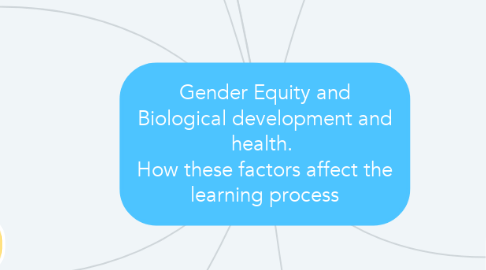
1. Gender definition
1.1. They are the attitudes and behaviors accepted by society as appropriate ways of being a woman or a man.
2. Parity, equality and equity
2.1. Gender parity refers to the same proportion of girls and boys who enter and complete school.
2.2. Equality aims to ensure that everyone gets the same.
2.3. Equity means making sure that people have access to the same opportunities to have and enjoy a full and healthy life.
3. Gender equality and equity in education
3.1. Education equity and equality are based on the premise that an individual´s level of education is correlated directly to future quality of life and can access to equal resources.
4. Cuases of gender discrimination in education
4.1. It is the unfair treatment of girls and denial of opportunities and violation of rights.
4.1.1. Political factors
4.1.1.1. Promote peace, in education, political representation and economic participation.
4.1.2. Socio- economic factors
4.1.2.1. Poverty is preventing to access to education
4.1.3. Socio- cultural factors
4.1.3.1. Patriarchal society seems to influence some decisions in some cultures.
5. Skateholder to get the gender equity
5.1. There are Government, parents, schools, teachers and students.
5.1.1. Responsibility of Government:
5.1.1.1. To apply that the constitution says in terms of the right of education and non-discrimination for girls.
5.1.1.2. To build equitable and inclusive education systems
5.1.2. Responsibility of parents
5.1.2.1. They ensuring their children go to school and for providing equal affective, encouraging and material support
5.1.3. Responsibility of schools and teachers
5.1.3.1. Promove inclusive teaching practices and fair disciplinary rules and promoting discussions on gender issues, as long will maintain the critical thinking.
5.1.4. Responsibility of students.
5.1.4.1. Ensuring their inclusion and for demanding that the right of education is equal for both boys and girls
6. The procees of gender equity construction
6.1. Train the teachers in inclusive teaching practices and in equitable students’ treatment.
6.2. End academic coursing based on gender stereotypes
6.3. Train the teachers to prevent violence and enforcing teacher codes of conduct.
6.4. Examine, critically, the influence of the global culture on gender.
7. These two issues are related because gender inequality and discrimination prevent many children from being able to function in a healthy learning environment, likewise due to health problems many children do not perform as they should in terms of academic achievement.
8. Created by: Amy Garcia
9. Biological development
9.1. Growth refers to increase in size, length, height and weight. It is one of the parts of the developmental process.
9.2. Development implies overall changes in the individual.
9.3. The pre- nata stages of development.
9.3.1. It is a period of remarkable change that helps set the stage for future psychological development
9.4. Brain devolpment before birth.
9.4.1. Human brain development takes place in the third gestational week and extends at least through late adolescence
9.5. Grow and development statement in infants and children.
9.5.1. Child development covers the following skills: -Cognition -Social interaction and emotional regulation -Speech and Language -Physical skills – fine motor (finger) skills and gross motor (whole body) skills -Sensory awareness
9.5.2. The grow covers the child during prenatal care and up to 1 year old.
9.6. The biology of child development learning.
9.6.1. Rapidity of brain development during early child-hood
9.6.2. The impact of stress on development
9.6.3. Individual differences in sensitivity to environments
9.6.4. The interplay of genes and environment.
9.7. The biology of adolescent development.
9.7.1. Adolescence is the transition period between childhood and adulthood. It is the name of the 10 to 20 year period.
10. How health affects a child and an adolescent`s school and performance.
10.1. The relationship between school performance and various health concerns includes the following issues:
10.1.1. -Poor sleep= poor grades. -Exercise: improves cognition, mood, attention and academic achievement. -Importance of breakfast: Children with anemia may have academic disadvantages. -Obesity: A lower quality of life among children. -Asthma. -Chronic health problems: Can affect children´s school attendance and achievement
